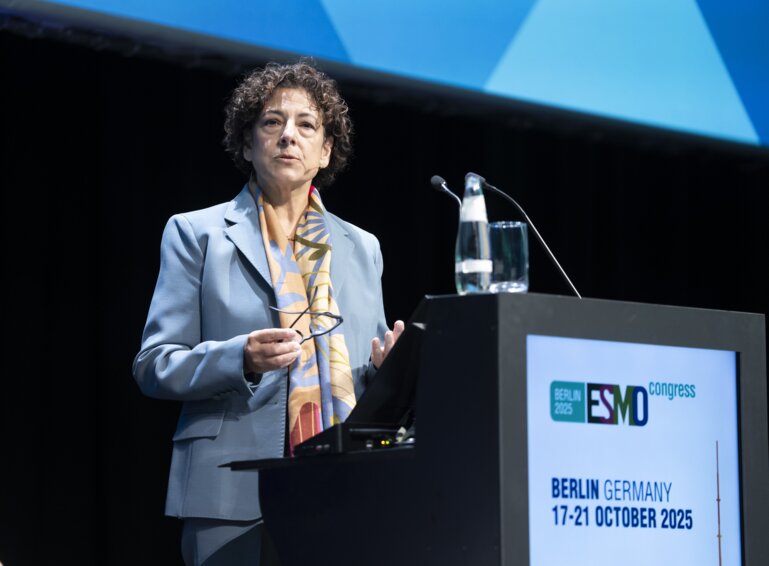Encouraging preliminary results are reported with innovative antibody–drug conjugate designs, but underlying mechanisms of action still need to be described to improve efficacy and tolerability
Ten years after the first regulatory approval of an antibody–drug conjugate (ADC) in the treatment of a solid tumour – with the US FDA authorisation of trastuzumab emtansine for HER2-positive metastatic breast cancer – data from three early-phase trials presented at the ESMO Congress 2023 (Madrid, 20–24 October) illustrate progress made and future directions.
Results from the ongoing phase Ib/II BEGONIA platform trial support the promise of the anti-TROP2 ADC datopotamab deruxtecan in combination with durvalumab for the first-line treatment of unresectable, locally advanced/metastatic triple-negative breast cancer (TNBC) (Abstract 379MO). Among 62 patients treated, the confirmed objective response rate (ORR) was 79%, including 6 complete responses. Response was irrespective of tumour PD-L1 expression level. The median duration of response was 15.5 months and the median progression-free survival (PFS) was 13.8 months (95% confidence interval [CI] 11–not calculable). The most common adverse events (AEs) were nausea and stomatitis (65% each), 57% of patients had grade 3–4 AEs and 23% reported serious AEs. Rates of anaemia, diarrhoea and neutropenia were low (15%, 13% and 5%, respectively). Three patients had grade 2 treatment-related interstitial lung disease (ILD)/pneumonitis. There were no treatment-related (TR)AE-related deaths but 16% of patients had AE-related treatment discontinuation.
Commenting on the efficacy results, Prof. Barbara Pistilli from Institut Gustave Roussy, Villejuif, France, says the data confirm earlier findings presented at the ESMO Breast Cancer Congress 2022 (Ann Oncol. 2022:33[Suppl 3]:S194–S223). “They show very promising activity, not only in terms of ORR, which was even higher than had previously been reported – 79% versus 74% – but also for PFS, where 13.8 months for TNBC in the first-line setting is really appealing. I look forward to seeing confirmation of these results in phase III trials.”
The other two presentations investigated ADCs with innovative designs. The first shared results from the phase II cohort of patients with pre-treated hormone receptor-positive, HER2-negative metastatic breast cancer from a trial with SKB264, a novel anti-TROP2 ADC with a sulfonyl pyrimidine-CL2A-carbonate linker conjugated to a topoisomerase I inhibitor payload (Abstract 380MO). TRAEs of grade ≥3 were reported in 48.8% of 41 patients, most commonly reductions in counts of neutrophils (36.6%), white blood cells (22.0%) and platelets (9.8%), along with anemia (14.6%) and gamma-glutamyl transpeptidase increase (7.3%). TRAEs led to dose reduction in 5 patients (12.2%) and dose delay in 7 patients (17.1%), but there were no treatment discontinuations or deaths, and no reports of neuropathy or drug-related ILD/pneumonitis. The ORR was 36.8%, the disease control rate was 89.5% and the median PFS was 11.1 months (95% CI 5.4–13.1).
SKB264 targets TROP2 in the same way and uses the same class of payload as most third-generation ADCs currently being using in the clinic. “However, while the linker in many existing agents can result in deconjugation of the ADC when it is still in the bloodstream, potentially leading to off-target toxicity and reduced efficacy, SKB264 incorporates a more stable linker, enabling it to more selectively release the payload in the tumour cell,” Pistilli explains. “Given the considerable technological efforts that have been made to generate this agent, it is all the more disappointing to see higher levels of haematological toxicity than might have been expected. Grade 3 and higher anaemia and leukopenia occur even more frequently than we have seen previously with sacituzumab govitecan in the ASCENT (N Engl J Med. 2021;384:1529–1541) and TROPiCS-02 (J Clin Oncol. 2022;40:3365–3376) trials. We will have to wait for results on tolerability and efficacy from ongoing trials, including a phase III trial in pre-treated TNBC (NCT05347134), before we can more accurately assess the therapeutic potential of SKB264.”
The last of the presentations reported first-in-human results of HS-20089, an ADC with a novel target, the transmembrane glycoprotein B7-H4 (Abstract 381O). Of the 52 patients with advanced solid tumours treated so far, including 48 with breast cancers, 3 experienced dose-limiting toxicities: 2 patients at 7.2 mg/kg and 1 patient at 5.8 mg/kg. Common TRAEs included decreased counts of white blood cells, neutrophils and platelets, anaemia, nausea, vomiting and increases in liver function tests. There were no reports of ILD or infusion reactions. Of 28 efficacy-evaluable patients with TNBC, ORR was 28.6% (95% CI 13.2–48.7) and disease control rate was 75.0% (95% CI 55.1–89.3). At the potential target therapeutic dose (4.8 and 5.8 mg/kg), respective ORRs were 33.3% and 27.3% in 23 patients with TNBC.
Observing that these preliminary results look promising and merit further exploration in clinical studies, Pistilli also notes that: “While the novel, distinct tumour-associated target, B7-H4, which is related both to immune escape and to tumour cell proliferation and invasion, presents a new approach for directing treatment, the mechanism of action of HS-20089 remains somewhat of a mystery, because the payload has not yet been disclosed.”
With around 130 agents currently in development, research in breast cancer is leading the way to expand the application of ADCs in the treatment of solid tumours. However, Pistilli cautions that there are still some unknowns. “A better understanding of the modes of action of these agents, their fate following tumour cell internalisation, the minimum target threshold for activity and mechanisms of resistance will help us to properly define the place of ADCs in the therapeutic continuum for breast cancer,” she concludes.
Abstracts discussed:
Schmid P, et al. Datopotamab deruxtecan (Dato-DXd) + durvalumab (d) as first-line (1L) treatment for unresectable locally advanced/metastatic triple-negative breast cancer (A/MTNBC): updated results from BEGONIA, a phase 1b/2 study. ESMO Congress 2023, Abstract 379MO
Mini Oral Session – Breast cancer, metastatic, 22.10.2023, h. 08:30 – 09:55, Bilbao Auditorium – NCC
Ouyang Q, et al. SKB264 (MK-2870) in previously treated hormone receptor-positive (HR+)/HER2-negative metastatic breast cancer (MBC): results from a phase I/II, single-arm, basket trial. ESMO Congress 2023, Abstract 380MO
Mini Oral Session – Breast cancer, metastatic, 22.10.2023, h. 08:30 – 09:55, Bilbao Auditorium – NCC
Wu J, et al. First-in-human/phase I trial of HS-20089, a B7-H4 ADC, in patients with advanced solid tumors. ESMO Congress 2023, Abstract 381O
Proffered Paper Session – Breast cancer, metastatic, 21.10.2023, h. 10:15 – 11:35, Barcelona Auditorium – Hall 9







